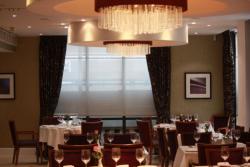 50 Connaught St, W2 2AA www.bombay-palace.co.uk
50 Connaught St, W2 2AA www.bombay-palace.co.uk
Arguably, everyone loves a curry. But, as any discerning fellow knows, there’s curry and there’s curry. There’s the huge vats of base gravy turned into sickly-sweet kormas; dull, derivative dhansaks; or vicious, volcanic vindaloos. Then there are scratch cooked, silky, butter-based sauces; bright green, spanking fresh herbal preparations; and thick, nut-enriched pastes.
And Bombay Palace are firm champions of the latter bunch. With a strong global presence and an excellent pedigree, August sees the welcome return of the restaurant to London. The original restaurant established itself as a high-end stalwart back in 1981, offering punters another, long-overdue option in the under-represented field of Indian fine dining.
Head chef Harjeet Singh earned his spicy stripes at legendary Delhi diners Bukhara and Dum Phunkt- and the influence is evident in the quality of the North West Frontier dishes on the menu. The standard stays with starters roaming the subcontinent; elegant mouthfuls of the well-loved street snack dahi batata poori; shikampuri kebabs with their pate-like consistency; and… what’s that coming over the hill, is it a lobster? No- just the hugest tandoori prawn ever.
Onto mains, a bit of a cabinet reshuffle required to do them justice. Green-marinated changezi champen lamb chops are a revelation for anyone fond of spiking their Sunday roast with mint sauce. Chunks of Goan kingfish are meaty morsels indeed, flattered into submission by tart raw mango and coconut; and juicy murgh makhni literally lives up to its unctuous name- butter-rich and smooth as silk.
As you come to expect from a nation with such a tradition of vegetarianism, vegetable dishes are both numerous and diverse. Shredded okra, battered and fried to an audible crispness, is a dish savoury enough to redeem the much-maligned bhindi, whilst tarka dahl is tangy, garlicky and tasty as you like. Karela may be a rather bitter pill to swallow, but Bombay Palace’s masala treatment takes it from astringent to astronomically good.
That tandoor works its magic on fluffy naans, flaky, potato stuffed parathas and the flavoursome, sunset-hued missi roti- an unusual treat on a restaurant menu. Although pud doesn’t venture into uncharted territory, kulfi comes as creamy and dense as you hope, and gajar halwa is served warm, oozing ghee and gratifyingly loose, rather than being compressed into the ubiquitous miserly disc of disappointment.
Glossy, muted glam and smart service puts the Bombay Palace experience up there with the likes of Tamarind, Amaya, Benares or Quilon- the few Indian elite who manage to pepper the good food guides only too lightly. The ingredients, technique, skill and expertise involved in executing Indian cuisine well can, and should, rival any Western fine dining experience. The new Bombay Palace may just widen a few eyes- and perhaps a few horizons to boot.
